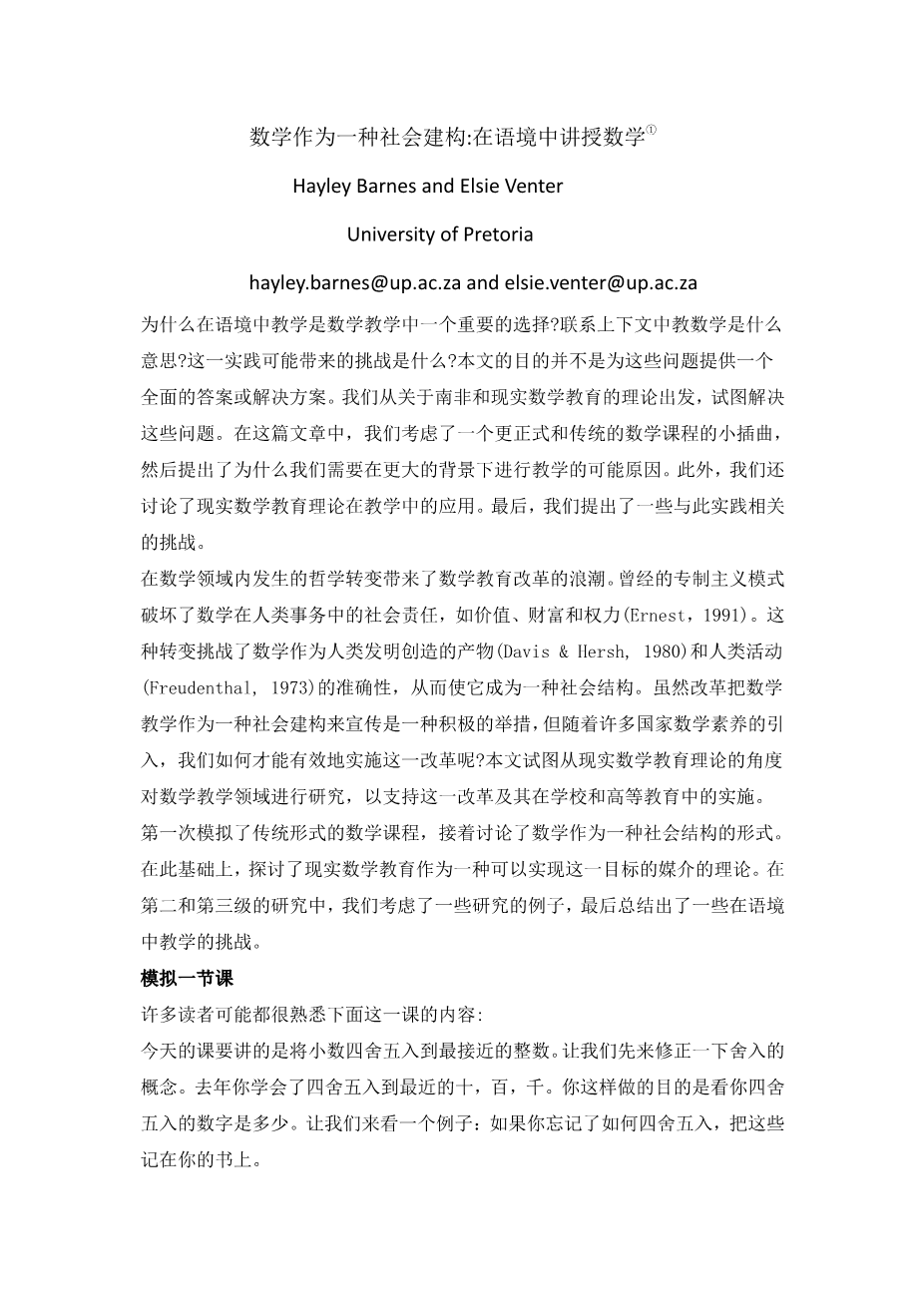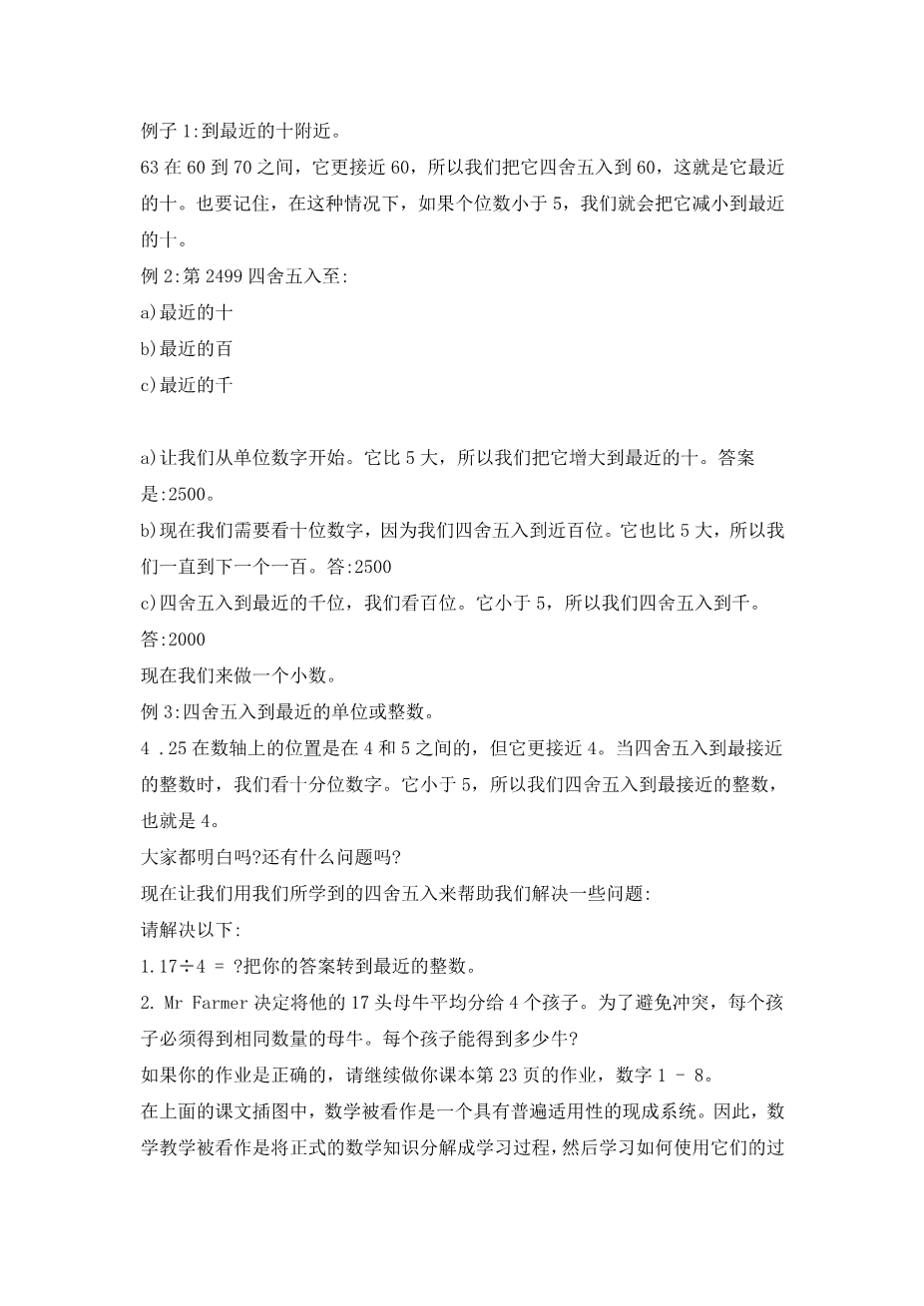Mathematics as a Social Construct:
Teaching Mathematics in Context
Hayley Barnes and Elsie Venter University of Pretoria
hayley.barnes@up.ac.za and elsie.venter@up.ac.za
Why is teaching in context an important option to consider in the teaching of mathematics? What does it mean to teach mathematics from and in contexts? And what are the possible challenges associated with this practice? The aim of this paper is not to provide a comprehensive answer or solution to these questions. We attempt rather to address these questions specifically with regard to South Africa and the theory of Realistic Mathematics Education. In this article we consider a vignette of a more formal and traditional mathematics lesson and then suggest possible reasons why we need to be teaching more in context. Furthermore we discuss the application of the theory of Realistic Mathematics Education as a potential approach to facilitate teaching in context. Finally we present some challenges associated with this practice.
The philosophical shift that has occurred within the domain of mathematics has brought with it a wave of reform in mathematics education. The former absolutist paradigm that dominated undermined the social responsibility of mathematics in human affairs such as value, wealth and power (Ernest, 1991). The shift has challenged the infallibility of mathematics and acknowledged it as a product of human inventiveness (Davis amp; Hersh, 1980) and a human activity (Freudenthal, 1973), thus making it a social construct. While the reform propagating the teaching of mathematics as a social construct is a positive move, along with the introduction of mathematical literacy in many countries, how can we effectively implement this reform? This paper seeks to examine the area of teaching mathematics in context (specifically in relation to the theory of Realistic Mathematics Education) to support this reform and the implementation thereof in school and tertiary education.
A vignette of a traditional formal mathematics lesson is first simulated, followed by a discussion of mathematics as a social construct. The relevance of teaching in context is then explored while alluding to the theory of Realistic Mathematics Education as a vehicle through which this can be done. Examples of studies conducted at secondary and tertiary level are considered, concluding with some challenges of teaching in context.
A lesson simulation
The following vignette of a lesson will probably be familiar to many readers:
Today’s lesson is going to look at rounding off decimals to the nearest whole number. Let us first revise the concept of rounding off. Remember that rounding off helps us in estimation. Last year you learnt to round off to the nearest ten, hundred and thousand. You did this by looking at which ten, hundred or thousand the number you are rounding off is closest to. Let’s look at an example. Write this down in your books if you have forgotten how to round off:
Example 1: Round 63 off to the nearest ten.
On the number line 63 lies between 60 and 70. It lies closer to 60 though so we round it off to 60, as the nearest ten. Remember also that in this case, if the units digit is less than the number 5, we round down to the nearest ten.
Example 2: Round 2 499 off to:
a)the nearest ten
b)the nearest hundred
c)the nearest thousand
a)Let us start by looking at the units digit. It is more than 5 so we round up to the nearest ten. The answer is therefore: 2 500
b)Now we need to look at the tens digit because we are rounding off to the nearest hundred. It is also more than 5 so we round up to the next hundred. Answer: 2 500
c)For rounding off to the nearest thousand we look at the hundreds digit. It is less than 5 so we round down to the nearest thousand.
Answer: 2 000
Now let us do one with decimals.
Example 3: Round 4,25 off to the nearest unit or whole number.
4,25 lies on the number line between the units/whole numbers 4 and 5. It is closer to 4 though. Also when rounding off the nearest whole number, we look at the tenths digit. It is less than 5 so we round down to the nearest whole number which is 4.
Does everyone understand? Are there any questions?
Now let us use what we have learnt about rounding off to help us solve some problems:
Please solve the following:
1.17 ÷ 4 = ? Round your answer off to the nearest whole number.
2.Mr Farmer decides to share his 17 cows evenly between his 4 children. To avoid conflict, each child must receive the same number of cows. How many cows will each child get?
If you have the class work correct, please continue with the homework which is page 23 of your textbook, numbers 1 – 8.
In the approach applied in the lesson vignette above, mathematics is viewed as a ready-made system with general applicability. Consequently, mathematics instruction is seen as a process of breaking up formal mathematical knowledge into learning procedures and then learning to use them accordingly.
Let us examine another similar problem to Example 3 above:
The problem:
17 people are trapped on a mountain and need to be rescued by helicopter. The helicopter can take a maximum of 4 passengers at a time, in addition to the pilot. How many trips will the helicopter need to make?
This example illustrates where conventional mathematics as we perform it outside of any prescribed context, can actually support or conflict with the answer depending on the context of the problem. In solving the problem above, it is the context that must take preference over the mathematical convention of rounding off “down” to the nearest whole number when our indicator is belo
剩余内容已隐藏,支付完成后下载完整资料


英语译文共 7 页,剩余内容已隐藏,支付完成后下载完整资料
资料编号:[462463],资料为PDF文档或Word文档,PDF文档可免费转换为Word


